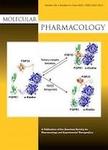版权所有:内蒙古大学图书馆 技术提供:维普资讯• 智图
内蒙古自治区呼和浩特市赛罕区大学西街235号 邮编: 010021

作者机构:Karolinska Inst Dept Physiol & Pharmacol Sect Mol Neuropharmacol S-17177 Stockholm Sweden
出 版 物:《MOLECULAR PHARMACOLOGY》 (分子药理学)
年 卷 期:2000年第58卷第4期
页 面:771-777页
核心收录:
学科分类:1007[医学-药学(可授医学、理学学位)] 10[医学]
主 题:细胞膜/代谢 纹状体/代谢 环AMP/代谢 GTP结合蛋白质α亚单位 GTP结合蛋白质α亚单位 Gs/遗传学 GTP结合蛋白质α亚单位 Gs/代谢 异源三聚体GTP结合蛋白质类/遗传学 异源三聚体GTP结合蛋白质类/代谢 前脑/代谢 RNA 信使/代谢 大鼠 Sprague-Dawley 受体 腺苷A2A 受体 嘌呤能P1/遗传学 受体 嘌呤能P1/代谢 动物 男(雄)性 大鼠
摘 要:In situ hybridization with cRNA probes showed A(2A) receptor and G(olf) mRNAs to be abundantly expressed in caudate putamen, nucleus accumbens, and olfactory tubercle, whereas G(s) mRNA shows a comparatively low expression in regions expressing A(2A) receptors. In caudate putamen, 49% of the medium-sized neuron-like cells exhibited a strong signal for adenosine A(2A) receptor mRNA, and 98% showed a strong signal for G(olf) mRNA. In contrast, G(s) mRNA was found in only 12% of the medium-sized neuron-like cells in caudate putamen. The coexpression of adenosine A(2A) receptor mRNA with that of G(olf) or G(s) mRNAs was studied with double in situ hybridization. A large majority (91-95%) of the neurons in caudate-putamen that contained adenosine A(2A) receptor mRNA also expressed G(olf) mRNA, whereas only 3 to 5% of the neurons with adenosine A(2A) receptor mRNA coexpressed G(s) mRNA. The A(2A) receptor agonist CGS 21680 [2-[p-(2-carbonylethyl) phenylethylamino-5 -N-ethylcarboxamidoadenosine] dose dependently activated Golf subunits in striatal membranes as shown by photolabeling with [ alpha-P-32]m-acetylanilido-GTP followed by immunoprecipitation with a specific antibody against G(olf). Transfection of G(olf) cDNA into Chinese hamster ovary cells, which stably express human adenosine A(2A) receptors, led to an increased efficacy of CGS 21680, as evidenced by a stronger cAMP response, indicating that activation of G(olf) by A(2A) receptors leads to a biological signal. In conclusion, these results provide anatomical and biochemical evidence that adenosine A(2A) receptors stimulate G(olf) rather than G(s) in striatum.